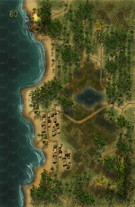Golden Sands of Waipuka
Dragon Rampant #6
|
|
(Attacker)
Japan
|
vs |
New Zealand
(Defender)
|
|
|
|
Total |
| Side 1 |
0 |
| Draw |
0 |
| Side 2 |
0 |
|
Total |
| Side 1 |
0 |
| Draw |
0 |
| Side 2 |
0 |
|
Total |
| Side 1 |
0 |
| Draw |
0 |
| Side 2 |
0 |
|
| Overall Rating, 0 votes |
|---|
|
|
|
Scenario Rank:
--- of 964 |
| Parent Game |
Dragon Rampant |
| Historicity |
Alt-History |
| Date |
1942-08-01 |
| Start Time |
09:00 |
| Turn Count |
30 |
| Visibility |
Day |
| Counters |
49 |
| Net Morale |
1 |
| Net Initiative |
2 |
| Maps |
2: 80, 83 |
| Layout Dimensions |
56 x 43 cm
22 x 17 in |
| Play Bounty |
223 |
| AAR Bounty |
223 |
| Total Plays |
0 |
| Total AARs |
0 |
|
Introduction
|
|
The beaches of Hawke's Bay on the North Island's eastern shore stood out to New Zealand defense planners as likely landing sites for Japanese invaders. Despite the strong current offshore, these offered broad, flat sands and a small port at Napier where reinforcements and heavy equipment could be unloaded. Coastal artillery and a garrison of Territorials kept watch here until August 1942, when the American landing on Guadalcanal appeared to end any possibility of a Japanese invasion.
|
|
Conclusion
|
|
Even in the darkest days of the Pacific War, a Japanese invasion of New Zealand was extremely unlikely, barring a complete collapse of Allied forces. The defenders would not have been the cream of the New Zealand Military Forces (those guys had all gone to the Middle East), but they would be fighting for their homeland.
|
Display Relevant AFV Rules
| AFV Rules Pertaining to this Scenario's Order of Battle |
- Vulnerable to results on the Assault Combat Chart (7.25, 7.63, ACC), and may be attacked by Anti-Tank fire (11.2, DFT). Anti-Tank fire only affects the individual unit fired upon (7.62, 11.0).
- AFV's are activated by tank leaders (3.2, 3.3, 5.42, 6.8).
They may also be activated as part of an initial activating stack, but if activated in this way would need a tank
leader in order to carry out combat movement.
- AFV's do not block Direct Fire (10.1).
- Full-strength AFV's with "armor efficiency" may make two anti-tank (AT) fire attacks per turn
(either in their action segment or during opportunity fire) if they have AT fire values of 0 or more
(11.2).
- Each unit with an AT fire value of 2 or more may fire at targets at a distance of between 100% and 150% of its
printed AT range. It does so at half its AT fire value. (11.3)
- Efficient and non-efficient AFV's may conduct two opportunity fires per turn if using direct fire
(7.44, 7.64).
Units with both Direct and AT Fire values may use either type of fire in the same turn as their opportunity fire,
but not both (7.22, 13.0).
Units which can take opportunity fire twice per turn do not have to target the same unit both times (13.0).
- Demoralized AFV's are not required to flee from units that do not have AT fire values (14.3).
- Place a Wreck marker when an AFV is eliminated in a bridge or town hex (16.3).
- AFV's do not benefit from Entrenchments (16.42).
- AFV's may Dig In (16.2).
- Closed-top AFV's: Immune to M, M1 and M2 results on Direct and Bombardment Fire Tables. Do not take step losses from Direct or Bombardment Fire. If X or #X result on Fire Table, make M morale check instead (7.25, 7.41, 7.61, BT, DFT).
- Closed-top AFV's: Provide the +1 modifier on the Assault Table when combined with infantry. (Modifier only applies to Germans in all scenarios; Soviet Guards in scenarios taking place after 1942; Polish, US and Commonwealth in scenarios taking place after 1943.) (ACC)
- Tank: all are closed-top and provide the +1 Assault bonus, when applicable
- River Vessels: see Rule 15.2 ~ 15.22
|
New Zealand Order of Battle





 DrRa005
DrRa005 






















